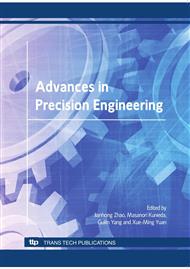p.376
p.381
p.386
p.391
p.396
p.401
p.406
p.412
p.417
Fabrication and Molding Testing of the Blazed Gratings for Microoptics Applications
Abstract:
This paper presents the experimental investigation of the optimal hot embossing replication to prevent the nanoscale thermal deformation of microstructures replicated from the electroless Ni mold fabricated by the diamond tool-interfered scribing process. The fabricated microstructures have the blazed profile with a period of 2.0 ㎛ and a depth of 0.2 ㎛ and a thermoplastic material PMMA as the replica was used. The hot embossing molding was carried out under the several experimental conditions. In terms of a quality of surface smoothness, profile, sharp blaze edge, surface roughness, peak to valley Ry and optical performance of the replica, the PMMA microstructures replicated under the optimal conditions, were ideally identical with those in the mold in dimension, and it was found that the demolding temperature is the most important factor for replication. From optical testing, diffraction efficiency of the replica was measured, 87.6%, similar to that of the calculated value 89.6%, and the replica molded in other conditions showed the noticeable efficiency drop due to molding error.
Info:
Periodical:
Pages:
396-400
Citation:
Online since:
September 2010
Authors:
Keywords:
Price:
Сopyright:
© 2010 Trans Tech Publications Ltd. All Rights Reserved
Share:
Citation:


